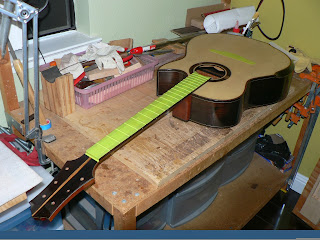I have a new project for an experimental nylon strings model. My goal is to make a guitar that has steel strings guitar like over tones using nylon strings. I am designing a guitar for Jazz and contemporary musicians. My
assumption is using an electrical pick-up system; therefore, my design does not
need loud voice. To generate a lot of over tones, I selected a lattice bracing design. A picture shown below is my new lattice bracing top. This has 5x5 lattice bracing configuration using 3mm thickness Sitka spruce. To make the brace lighter, I shaved as V-cross section. I also scalloped the lattice bracing. Lowest scalloped portion is at a little bit below the bridge. I want to make flexible portion at below the bridge to realize a cantilever like movement for the bridge. This top design might be able to create rich over tones effectively. I have never seen the top design like this.
This is my new lattice bracing pattern
Unlike my lattice bracing design, latest lattice bracing nylon strings guitars have Balsa wood bracing
with carbon fiber lamination using Epoxy resin. Those designs have less
than 1mm top board thickness with massive A-frame body using high
quality aerospace grade poly wood. This design was originally invented
by Greg Smallman. I do not believe the Smallman type design makes rich
over tones. His design improves efficiency for making more loud sound.
This means that his guitar works pretty effectively as a mechanical air
pump. Also, all of existing lattice bracing designs have the thickest (strongest) portion at the bridge, and tapered out to the top edges. This design makes much larger the top movement; therefore, the guitar works pretty effectively as an air pump to make loud sound. However, this design does not effectively contributes to generate rich over tones, because the bridge is very strongly coupled with the mechanically strongest top portion.

Typical bracing design for Smallman type guitars
My new guitar making might requires six month to complete at least. Once I complete this design, I would like to post sound samples to show how well my design generates rich over tones like steel strings guitars.
















































